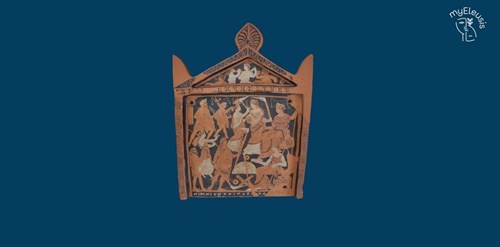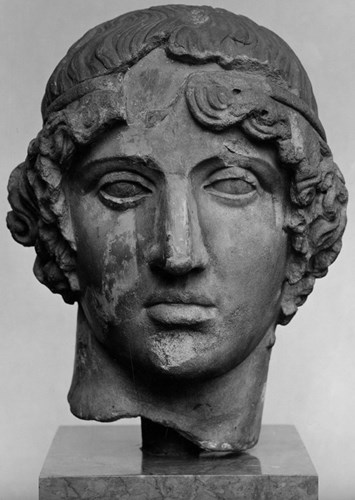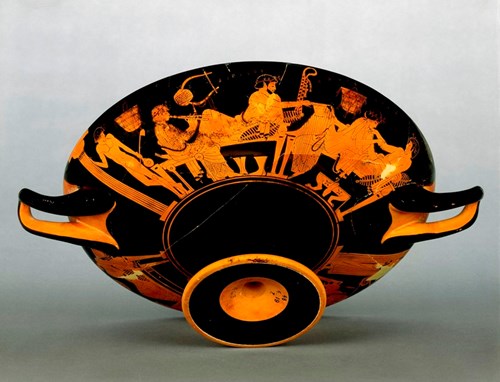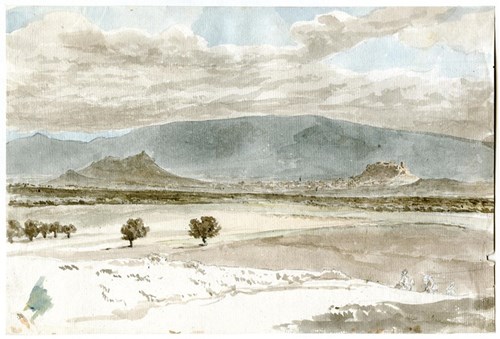The tablet of Ninnion
The Ninnion Tablet is the only original extant work of art that definitely represents the Eleusinian Mysteries’ initiation rites. The torches, the branches of myrtle tied with strands of wool (bakchoi), the myrtle wreaths, the kernoi, and the poppies are distinctive attributes and common symbols of Demeter’s cult. However, there have been many interpretations and theories regarding the identity of the figures and the complex iconography on the tablet. There is also disagreement on whether the scenes on the tablet constitute a unified whole or whether we should interpret them as two scenes that occur in different locations and at different times.

Image source: National Archaeological Museum of Athens // Ninnion Tablet, c. 370 BC
The researchers who favour a single composition with unity of place and time believe that the tablet depicts a procession of initiates (men, women, and children) towards the two goddesses (Demeter and Persephone) who are seated on the right. The two figures who carry torches act as intermediaries between mortals and gods and present the initiates to the deities of Eleusis. The woman in the upper scene is Hekate, while the young man in the lower scene is Iacchus.

Image source: The British Museum // Head of marble figure of an athlete or Iachos. Roman copy (120-180 CE) after a Greek original of about 470-460 BCE (bit.ly/3F37r1Q)
The scholars who support the other point of view argue that the votive pinax of Ninnion contains two different scenes. The upper scene depicts the Lesser Mysteries and takes place during the month of Anthesteron in the sacred sanctuary of the two goddesses in Agrai. The Ionic column in the upper left-hand corner represents the small Ionic temple on the shores of the river Ilissos. The woman bearing a torch is Kore, who leads the initiates to her mother, the goddess Demeter, who appears seated and holds a sceptre. In the lower scene, Iacchus (personification of the religious enthusiasm of those who participated in the celebration) presents the initiates to Demeter after their arrival to Eleusis on the night of the 19th of Boedromion.
In contrast to Persephone, who holds her torch high, Iacchus turns one of his torches towards the ground as a sign of respect for a superior goddess. Furthermore, the absence of Kore from the lower scene supports the theory that the event takes place during the Greater Mysteries (much like her presence in the upper scene is a strong indication that it depicts the Lesser Mysteries, where Persephone played a central role). Finally, the scene on the pediment shows the all-night celebration that took place in the courtyard of the sanctuary when the big procession of the initiates reached Eleusis from Athens.

Image source: The British Museum // The Brygos Painter: Symposium (490-480 BCE) (bit.ly/3yygNzW)
There have been many theories regarding the identity of Ninnion, the woman who dedicated the tablet to the goddesses. The dedicatory inscription with her name is incised on the bottom. The most widely held view claims that Ninnion was among the most famous courtesans who lived in Athens in the first half of the fourth century. She was born in approximately 375 BCE and became widely known around 350 BCE. The three scenes on the tablet (the two principal scenes in the main composition and the image on the pediment) present the same mortal woman (perhaps Ninnion herself) participating in various events associated with the celebration of the Mysteries. Ninnion is readily identified by the kernos borne on her head. In addition, a bearded man always accompanies her. Scholars argue he is Thallus, a foreigner who came to Athens to purchase dried figs and honey from Mount Hymettus, only to fall in love with Ninnion and waste his fortune on her.

Image source: The British Museum // Charles Robert Cockerell: Mount Hymettus (1811-1814) (bit.ly/3oZYoJr)
The red clay tablet was found in nine fragments in 1895. The plaque is relatively small (height: 0,44 m, width 0,32 m) and has four holes in the corners for fastening. Apotropaic words incised at the back served to protect the dedicator (?) from curses. The tablet is dated to the first half of the fourth century BCE. The original is at the National Archeological Museum in Athens, while an exact copy can be found at the Archeological Museum of Eleusis.
Bibliography
Αλεξοπούλου-Μπαγιά, Πόλλυ. Ιστορία της Ελευσίνας: Από την Προϊστορική μέχρι τη Ρωμαϊκή περίοδο, Ελευσίνα: Δήμος Ελευσίνας, 2005.
Mylonas, George. Eleusis and the Eleusinian Mysteries, London: Routledge, 1962.
Papangeli, Kalliopi.Eleusis: the archaeological site and the museum, Athens: Omilos Latsi, 2002.


